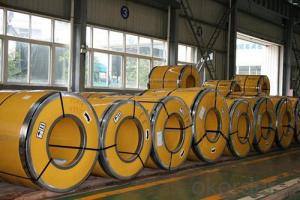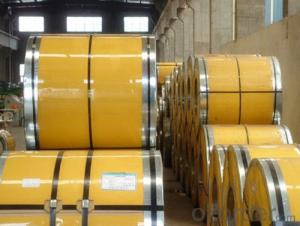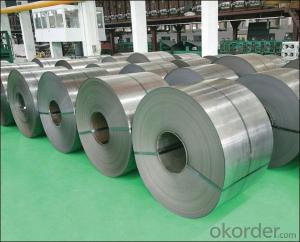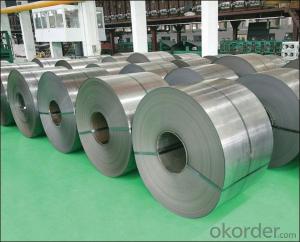Hot Rolled Stailess Steel Coil 300 Serious
- Loading Port:
- Tianjin
- Payment Terms:
- TT OR LC
- Min Order Qty:
- 25 m.t.
- Supply Capability:
- 100000 m.t./month
OKorder Service Pledge
OKorder Financial Service
You Might Also Like
Hot Rolled Stailess Steel Coil 300 Serious
1.Structure of Hot Rolled Stailess Steel Coil 300 Serious
Hot Rolled Stailess Steel Coil 300 Serious is one of the raw material of the cold rolled stainless steel strip, which can be used directly in many places. Stainless Steel (Stainless Steel) is short for acid-proof Stainless Steel, resistant to weak corrosive medium such as air, steam, water, or with a Stainless Steel grade.
2.Main Features of Hot Rolled Stailess Steel Coil 300 Serious
1) weldability: The purpose of the different requirement for welding performance are different.1 Kind of tableware generally do not require the performance of welding, even including some pot class enterprise. But the vast majority of products all need raw materials welding performance is good, like the 2 kinds of tableware, thermos flask, steel pipes, water heaters, water dispensers, etc.
2) Corrosion resistance The vast majority of stainless steel products for corrosion resistant performance is good, like a, 2 kinds of tableware, kitchen utensils and appliances, water heaters, water dispensers, etc., some foreign businessmen on corrosion resistance of products also do experiment: in NACL aqueous solution heated to boiling, after a period of time the best solution, wash and drying, weight loss, to determine the degree of corrosion (note: the product polishing, because of the sand cloth or sandpaper containing Fe, will cause the test surface rust spots)
3) Polishing performance In today's society stainless steel products in production after polishing the process commonly, when only a small number of products such as water heaters, water dispenser tank don't need polishing. So this will require materials polishing performance is very good. The factors influencing polishing performance mainly include the following: 1) raw material surface defects. Such as scratch, pitting, pickling, etc. (2) raw material problem. Hardness is too low, easy when polishing cast light (BQ), and the hardness is too low, the surface easily when deep drawing appear orange peel phenomenon, which affects the BQ. Relatively high hardness of BQ sex is good. (3) after deep drawing products, great deformation area surface will be a small black spots and RIDGING, thus affecting the BQ.
4) Heat resistant performance Heat resistant performance refers to the high temperature stainless steel can still maintain its excellent physical and mechanical properties. Carbon: the influence of carbon in austenitic stainless steel is formed strong and steady. Set the austenitic austenitic area and expand elements. Carbon formation of austenite is about 30 times that of the nickel, the ability of carbon is a kind of gap elements, through the solid solution strengthening can significantly increase the strength of the austenitic stainless steel. Carbon austenitic stainless steel can be improved in high concentration chloride (e.g., 42% MgCl2 boiling solution) in the performance of the resistance to stress corrosion. But, in the austenitic stainless steel, carbon is often seen as the harmful elements, this is mainly due to the corrosion of stainless steel used in some conditions, such as welding or heating by 450 ~ 850 ℃), carbon steel with chromium in forming high chromium Cr23C6 type carbon compounds which can lead to local chromium depletion, make steel corrosion resistance especially resistant to intergranular corrosion performance degradation. So. Since the 60 s of the development of new cr-ni austenitic stainless steel is mostly carbon content less than 0.03% or 0.02% of the ultra-low carbon type
5) Corrosion resistance When the atomic number of no less than 12.5% chromium content in steel, can make the steel electrode potential mutations, the negative potential to the positive electrode potential. To prevent electrochemical corrosion.
3. Hot Rolled Stailess Steel Coil 300 Serious Images
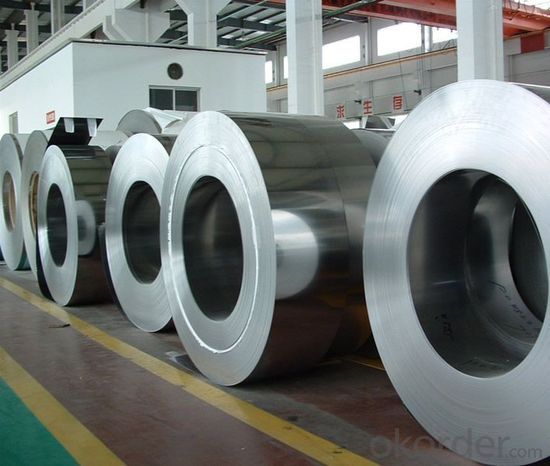
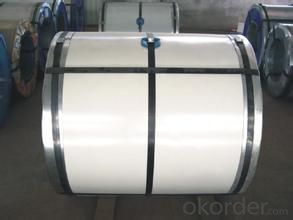
4. Hot Rolled Stailess Steel Coil 300 Serious Specification
The word "stainless steel" is not merely refers to a pure stainless steel, but said more than one hundred kinds of stainless steel industry, the development of each stainless steel has good performance in their specific applications. The key to the success of the first is to make clear purpose, and then determine the correct material. Related to architectural construction applications usually only six types of steel. They contain 17 ~ 22% chromium, good steel contains nickel. Add molybdenum can further improve the atmospheric corrosion resistance, especially containing chloride atmospheric corrosion resistance. Stainless steel often according to the state of organization can be divided into: martensite steel, ferritic steel, austenitic steel, austenitic (two-phase) - ferrite stainless steel and precipitation hardening stainless steel, etc. In addition, according to ingredients can be divided into: chromium stainless steel, chromium nickel stainless steel and chromium manganese nitrogen stainless steel, etc.
1) Ferritic stainless steel Chromium containing 15% ~ 30%. Its corrosion resistance, toughness and weldability with chromium content increases with the increase of chloride stress corrosion resistance is superior to other types of stainless steel, fall into this category of Crl7, Cr17Mo2Ti, Cr25, Cr25Mo3Ti, Cr28, etc. Ferritic stainless steel because of the high chromium content, corrosion resistance and oxidation resistance are relatively good, but the mechanical properties and process performance is poorer, more used to stress less acid structure and steel used as antioxidant. This kind of steel to withstand atmosphere, nitric acid and corrosion of the brine solution, and has good high temperature oxidation resistance, low thermal expansion coefficient, etc, used in nitric acid and food factory equipment, also can make work under high temperature parts, such as gas turbine parts, etc.
2) Austenitic stainless steel The title Chromium is more than 18%, still contain about 8% of the nickel and small amounts of molybdenum, titanium, nitrogen and other elements. Good comprehensive performance, corrosion resistant to a variety of media. Number of austenitic stainless steel is commonly used one cr18ni9, 0 cr19ni9, etc. In the Wc < 0.08% 0 cr19ni9 steel, steel grade is marked as "0". This class contains large amounts of Ni and Cr in steel, make steel in austenitic state at room temperature. This kind of steel has good plasticity and toughness, weldability and corrosion resistance and non-magnetic or weak magnetic, the corrosion resistance in oxidizing and reducing medium are good, used to make acid equipment, such as corrosion resistant containers and equipment lining, pipelines, nitric acid resistant equipment parts, etc., also can be used as the main body of watches and clocks jewelry stainless steel material. Austenitic stainless steel with solid solution treatment, the steel heating to 1050 ~ 1150 ℃, then water-cooled or air-cooled, for single-phase austenitic organization.
3) Austenitic, ferritic duplex stainless steel The advantages of both austenitic and ferritic stainless steel, and has the superplasticity. Austenite and ferrite The title Each accounts for about half of the stainless steel. In the case of contain low C, Cr content was 18% ~ 18%, Ni content at 3% ~ 3%. Some steel containing Mo, Cu, Si, Nb, Ti, N and other alloying elements. This kind of steel both austenite and ferrite stainless steel, the characteristics of compared with ferrite, plasticity and toughness is higher, no room temperature brittleness, intergranular corrosion resistance and welding performance were significantly increased, while maintaining a ferritic stainless steel of 475 ℃ brittleness and high thermal conductivity, has the characteristics of superplasticity. Compared with austenitic stainless steel, high strength and resistance to intergranular corrosion and resistance to chloride stress corrosion is improved obviously. Duplex stainless steel has excellent resistance to pitting corrosion performance, is also a kind of nickel and stainless steel.
4) Precipitation hardening stainless steel For austenitic or martensite structure matrix, and the number of precipitation hardening stainless steel commonly used such as 04 cr13ni8mo2al. It can pass the precipitation hardening (also known as the age hardening) dealing with the hard (strong) of stainless steel.
5) Precipitation hardening stainless steel For austenitic or martensite structure matrix, and the number of precipitation hardening stainless steel commonly used such as 04 cr13ni8mo2al. It can pass the precipitation hardening (also known as the age hardening) dealing with the hard (strong) of stainless steel.
5.FAQ of Hot Rolled Stailess Steel Coil 300 Serious
We have organized several common questions for our clients,may help you sincerely:
①How about your company?
A world class manufacturer & supplier of castings forging in carbon steel and alloy steel,is one of the large-scale professional investment casting production bases in China,consisting of both casting foundry forging and machining factory. Annually more than 8000 tons Precision casting and forging parts are exported to markets in Europe,
②How to guarantee the quality of the products?
We have established the international advanced quality management system,every link from raw material to final product we have strict quality test;We resolutely put an end to unqualified products flowing into the market. At the same time, we will provide necessary follow-up service assurance.
③What applications your products can have?
Kitchenware: tableware, cookware, Stoves…
Food packing: storage cans, food containers…
Construction: bridge, roofing, wall, decoration, bathroom accessories…
Precision instruments: electrical products, aerospace…
Others: automotive parts, machine building, chemical processing, farming…
- Q:What are the different types of coatings available for stainless steel strips?
- Stainless steel strips offer a variety of coating options, each with its own advantages and uses. 1. Electroplated coatings involve an electrochemical process that applies a thin layer of metal to the stainless steel strip. Common options include chrome, nickel, and zinc, which improve corrosion resistance and create an attractive finish. 2. Organic coatings, such as paint or powder coatings, act as a protective barrier against corrosion and enhance the appearance of the stainless steel strip. They come in a range of colors and finishes and also provide additional protection against chemicals, UV radiation, and abrasion. 3. PVD coatings are deposited onto the stainless steel strip using a vacuum-based process. Examples include titanium nitride, titanium carbonitride, and zirconium nitride. These coatings offer excellent wear resistance, hardness, and decorative finishes. 4. CVD coatings involve a chemical reaction to deposit a thin layer of material onto the stainless steel strip. Common options include diamond-like carbon (DLC) and titanium nitride. These coatings provide high hardness, low friction, and exceptional corrosion resistance. 5. Ceramic coatings, applied through thermal spray, offer outstanding wear resistance, thermal protection, and corrosion resistance. Popular choices include aluminum oxide, zirconium oxide, and titanium oxide. 6. Passivation is a chemical treatment that removes impurities from the stainless steel surface and forms a protective oxide layer. This process enhances the strip's corrosion resistance and durability. The selection of a coating for stainless steel strips depends on specific application requirements, such as desired corrosion resistance, aesthetics, wear resistance, and environmental factors.
- Q:Can stainless steel strips be used in the production of automotive exhaust systems?
- Yes, stainless steel strips can be used in the production of automotive exhaust systems. Stainless steel strips are often preferred for exhaust systems due to their high temperature resistance, corrosion resistance, and durability. They can withstand the extreme heat and corrosive gases generated by the engine, making them a suitable choice for this application.
- Q:Can stainless steel strips be used in heat exchangers?
- Heat exchangers can indeed utilize stainless steel strips. Stainless steel is a favored option for heat exchangers because of its remarkable resistance to corrosion, ability to withstand high temperatures, and durability. It can endure the challenging operating conditions and thermal fluctuations frequently encountered in heat exchanger applications. Furthermore, the sleek surface of stainless steel strips aids in reducing fouling and promoting efficient heat transfer. Moreover, stainless steel boasts commendable mechanical properties, rendering it appropriate for different types of heat exchangers, including shell and tube, plate, and finned heat exchangers.
- Q:Can stainless steel strips be used in the petrochemical industry?
- Certainly, the petrochemical industry finds stainless steel strips to be a valuable asset. The exceptional corrosion resistance of stainless steel renders it suitable for a wide range of applications in this sector. Given that petrochemical processes often involve the manipulation of various corrosive chemicals, gases, and liquids, stainless steel strips are frequently employed in the construction of storage tanks, pipelines, heat exchangers, and other necessary equipment. The indispensability of corrosion resistance in these structures cannot be overstated. Moreover, the high strength and durability of stainless steel endow it with the ability to withstand the demanding conditions of the petrochemical industry, including high temperatures and pressures. Consequently, it is safe to conclude that stainless steel strips are the preferred material in the petrochemical sector due to their corrosion resistance, strength, and longevity.
- Q:Are stainless steel strips suitable for automotive fuel systems?
- Yes, stainless steel strips are suitable for automotive fuel systems. Stainless steel is known for its high corrosion resistance, making it an ideal choice for fuel systems in vehicles. It can withstand exposure to gasoline and other fuel types without corroding or degrading over time. Additionally, stainless steel's strength and durability ensure that it can withstand the high pressures and temperatures associated with automotive fuel systems. This material also has excellent heat resistance properties, which is crucial in preventing fuel leaks and maintaining the safety of the system. Furthermore, stainless steel strips can be easily formed and fabricated into various shapes and sizes, allowing for flexible design options in fuel system components. Overall, stainless steel strips offer the necessary qualities required for automotive fuel systems, making them a suitable choice for this application.
- Q:What are the different types of perforation for stainless steel strips?
- There are several different types of perforation for stainless steel strips, including round, square, slotted, and decorative patterns. Each type of perforation serves a specific purpose and can be chosen based on the desired aesthetic, functionality, and application requirements.
- Q:Are 111 stainless steel strips suitable for cryogenic storage containers?
- Yes, 111 stainless steel strips are suitable for cryogenic storage containers.
- Q:What are the recommended cleaning agents for 111 stainless steel strips?
- Depending on the specific requirements and conditions of the stainless steel strips, the choice of cleaning agents recommended for 111 stainless steel strips may vary. However, there are some commonly suggested options for cleaning stainless steel, such as mild soap or detergent, non-abrasive cleaners, and specialized stainless steel cleaners. For regular cleaning of stainless steel strips, it is usually sufficient to use a mild soap or detergent along with warm water. This solution can be gently applied to the surface using a soft cloth or sponge. It is crucial to avoid using abrasive cleaners that contain bleach or chlorine, as they can harm the finish of the stainless steel. In case of tougher stains or stubborn dirt, non-abrasive cleaners specifically designed for stainless steel can be utilized. These cleaners are typically available in spray or liquid form and can be applied to the surface and wiped off with a clean cloth. It is essential to carefully follow the instructions provided by the manufacturer of the specific cleaner being used. Furthermore, there are specialized stainless steel cleaners available in the market that are formulated to eliminate fingerprints, smudges, and other marks from stainless steel surfaces. These cleaners are often available as sprays or wipes and can be used as needed to maintain the appearance of the stainless steel strips. It is always advisable to test any cleaning agent on a small and inconspicuous area of the stainless steel strips before applying it to the entire surface. This precaution ensures that the cleaning agent does not cause any damage or discoloration to the stainless steel. Additionally, it is important to adhere to the manufacturer's instructions for both the cleaning agents and the stainless steel strips to achieve optimal cleaning results and prevent any surface damage.
- Q:Can 111 stainless steel strips be laser cut for precise shapes?
- Yes, 111 stainless steel strips can be laser cut for precise shapes.
- Q:Can 111 stainless steel strips be used in marine environments?
- Yes, 111 stainless steel strips can be used in marine environments. 111 stainless steel is a low carbon, high chromium stainless steel that offers excellent resistance to corrosion in various environments, including marine environments. It has good strength and toughness, making it suitable for use in marine applications such as boat fittings, marine hardware, and offshore structures. Additionally, 111 stainless steel has good weldability and can withstand exposure to saltwater and other corrosive elements commonly found in marine environments. However, it is important to properly maintain and clean the stainless steel strips to ensure their long-term performance in marine environments.
1. Manufacturer Overview |
|
|---|---|
| Location | |
| Year Established | |
| Annual Output Value | |
| Main Markets | |
| Company Certifications | |
2. Manufacturer Certificates |
|
|---|---|
| a) Certification Name | |
| Range | |
| Reference | |
| Validity Period | |
3. Manufacturer Capability |
|
|---|---|
| a)Trade Capacity | |
| Nearest Port | |
| Export Percentage | |
| No.of Employees in Trade Department | |
| Language Spoken: | |
| b)Factory Information | |
| Factory Size: | |
| No. of Production Lines | |
| Contract Manufacturing | |
| Product Price Range | |
Send your message to us
Hot Rolled Stailess Steel Coil 300 Serious
- Loading Port:
- Tianjin
- Payment Terms:
- TT OR LC
- Min Order Qty:
- 25 m.t.
- Supply Capability:
- 100000 m.t./month
OKorder Service Pledge
OKorder Financial Service
Similar products
New products
Hot products
Hot Searches
Related keywords
